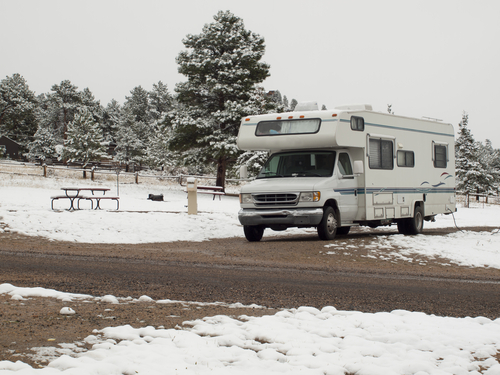For RV owners who aren’t fortunate enough to travel full time the need to store your vehicle will eventually arise. If you don’t have a full sized RV garage built into your home, or extra space in your driveway, you’ll probably end up at a storage facility capable of storing your RV sooner or later. Although it may seem like you can just park your RV, lock it, and return many months later, there are a few steps you’ll want to take to ensure your RV is in top shape come next season.

The Storage Space
The first step to successful RV storage is to find a good space. Generally speaking you’ll have two options available; open or enclosed spaces. Open spaces are best for people who live in warm, arid regions. The combination of warm weather and a lack of humidity create the perfect environment for storing your RV. However, if you live in an area that has damp, cold, or the possibility for extreme weather your best bet is an enclosed space. After additional security, one perk to enclosed spaces is the opportunity to have it climate controlled. A climate controlled space will reduce the amount of work you need to do to winterize your vehicle, as well as reduce the wear and tear on your RV by eliminating extreme temperature and humidity changes.
Clean the RV
Before placing your RV in storage you’ll want to clean the entire inside and outside. Follow normal vehicle washing procedures and include a UV protective car wax or other RV safe coating. This will reduce the opportunity for rust or other unwanted visitors like dust, or sunlight from damaging your paint job. Vacuum the carpets, scrub the shower, toilet, and counters. Take extra care to clean appliances like ovens, microwaves, and refrigerators. Additionally remove all food items as this will prevent odor buildup and reduce the likelihood that rodents will try to make their home in your RV.
No H2O
You’ll want to remove all the water from your RV’s pipes, tanks, and drains to prevent them from freezing or growing mildew. Use compressed air to clear pipes and water lines. Take extra caution for plastic, rubber, old, or weak water lines as the compressed air may damage them. Empty the water from fresh water tanks, as well as the water heater and toilet. To prevent any remaining water from freezing and damaging the lines you can flush RV safe anti-freeze through the lines and tanks. This isn’t the same stuff you put in your car so you’ll need to verify that it is RV safe (non-toxic and suitable for use in potable water supplies). To err on the safe side you can place about 1 cup of RV safe anti-freeze in every drain.
Engine and Battery Prep
In order to prevent damage to your engine or fuel system while the RV is in storage you’ll need to top off all the fluids. If you’ve just finished up traveling and plan to lock up your RV for a few months consider having the oil changed and all the fluids checked. Be sure to tell the mechanic that you’re planning on storing your RV for the off season so they can offer you the best products. To protect your battery you’ll want to have it fully charged before storing. Turn off the RV circuit breaker and all electrical systems and appliances before storing. This will prevent battery drain and prolong the life of your batter. If you live in extremely harsh conditions and don’t plan to put your RV in a climate controlled unit it may be best to keep the battery inside your garage. Follow storage and handling instructions printed on the battery for best results and safety.
Protect the Tires
Sitting for long periods of time can cause damage to your RV’s tires. To prevent this use your RV’s jacks to lift some of the weight from the tires (be sure to consult your owner’s manual about long term jack use first). If jacks aren’t an option you can return to your RV once a month and move your RV a half rotation each time to prevent the fullness of the RV’s weight from resting on the same spot. If your RV will be parked in direct sunlight use tire covers to prevent the sun from damaging the rubber while in storage.
Invest in a Full-Sized RV Cover
Purchasing a full-sized RV cover is one of the best ways you can protect your investment. A cover will prevent rain and hail from contacting the RV’s paint as well as protecting the plastic and rubber portions from encountering the sun’s damaging UV rays. For best results, put the cover on after you’ve washed the entirety of the RV’s outer surface.
Additional Concerns
Place a few open boxes of baking soda inside appliances like refrigerators, freezers, and microwaves to keep odors at bay. Close all blinds and window shades to prevent the sun from damaging furniture and carpet. Empty all trash containers and remove all food items including crumbs and canned food to prevent rodents from entering your RV. Disconnect and store all liquid gas canisters as per local and storage facility regulations. If stored properly your RV will remain in top shape and be ready for use upon your return.























